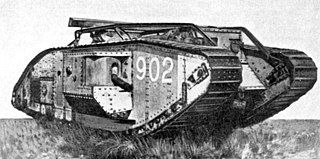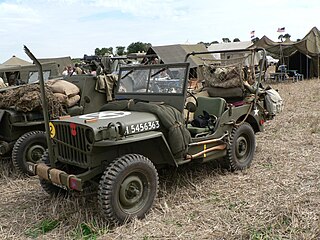This article includes a list of references, related reading or external links, but its sources remain unclear because it lacks inline citations .(June 2021) |
Killen-Strait was an American engineering company.

This article includes a list of references, related reading or external links, but its sources remain unclear because it lacks inline citations .(June 2021) |
Killen-Strait was an American engineering company.

The company made tractors. The company came from Killen-Walsh Manufacturing Company, which changed its name to Killen-Strait in 1914, to build the Strait's Tractor.
It was based in Appleton, Wisconsin in the USA.[ citation needed ]
The Killen-Strait Tractor was powered by a choice of 25-40HP Waukesha Engines, with Remy ignition systems. Two models of tractor were built - a 30-50 model and a 15-30 model. [1]
A Killen-Strait Tractor took part in a demonstration on 30 June 1915 at Wembley Park, in front of Winston Churchill and David Lloyd George as a vehicle that could cross obstacles and cut barbed wire. On the same day, the War Office had passed its specification for a machine gun destroyer to the Admiralty's Landship Committee (based at 83 Pall Mall). From the demonstration of the tractor cutting barbed wire, responsibility of the Landship Committee was passed from the Admiralty to the new Ministry of Munitions. The tracked Killen-Strait Tractor significantly inspired the design of what would later that year become the tank. The tracked Killen-Strait Tractor had one track at the front and two at the back. It was fitted with bodywork of an armoured car in 1915. [2]

The history of the tank begins with World War I, when armoured all-terrain fighting vehicles were introduced as a response to the problems of trench warfare, ushering in a new era of mechanized warfare. Though initially crude and unreliable, tanks eventually became a mainstay of ground armies. By World War II, tank design had advanced significantly, and tanks were used in quantity in all land theatres of the war. The Cold War saw the rise of modern tank doctrine and the rise of the general-purpose main battle tank. The tank still provides the backbone to land combat operations in the 21st century.

The Schneider CA 1 was the first French tank, developed during the First World War.
The Landship Committee was a small British committee formed during the First World War to develop armoured fighting vehicles for use on the Western Front. The eventual outcome was the creation of what is now called the tank. Established in February 1915 by First Lord of the Admiralty Winston Churchill, the Committee was composed mainly of naval officers, politicians and engineers. It was chaired by Eustace Tennyson d’Eyncourt, Director of Naval Construction at the Admiralty. For secrecy, by December 1915 the name was changed to "the D.N.C.'s Committee" to disguise its purpose.

British heavy tanks were a series of related armoured fighting vehicles developed by the UK during the First World War.

The Mark IX tank was a British armoured fighting vehicle from the First World War. It was the world's first specialised armoured personnel carrier (APC).

The Gun Carrier Mark I was a British vehicle of the First World War. The gun carrier was designed to transport a 6-inch howitzer or a 60-pounder gun forward soon after an attack to support infantry in advanced positions. Gun carriers were first used in the Battle of Pilckem Ridge during the Third Battle of Ypres. The carriers moved guns and equipment but were used for the rest of the war mainly for carrying equipment and supplies through areas under fire, where porters in the open would have suffered many casualties. The 6-inch howitzer could be fired while mounted, making the Gun Carrier Mark I the first modern self-propelled gun, a weapon capable of independent action and having tactical mobility on the battlefield.

The development of tanks in World War I was a response to the stalemate that developed on the Western Front. Although vehicles that incorporated the basic principles of the tank had been projected in the decade or so before the War, it was the alarmingly heavy casualties of the start of its trench warfare that stimulated development. Research took place in both Great Britain and France, with Germany only belatedly following the Allies' lead.

Little Willie was a prototype in the development of the British Mark I tank. Constructed in the autumn of 1915 at the behest of the Landship Committee, it was the first completed tank prototype in history. Little Willie is the oldest surviving individual tank, and is preserved as one of the most famous pieces in the collection of The Tank Museum, Bovington, England.

Major-General Sir Ernest Dunlop Swinton, was a British Army officer who played a part in the development and adoption of the tank during the First World War. He was also a war correspondent and author of several short stories on military themes. He is credited, along with fellow officer Lieutenant-Colonel Walter Dally Jones, with having initiated the use of the word "tank" as a code-name for the first tracked, armoured fighting vehicles.

Cultivator No. 6 was the code name of a military trench-digging machine developed by the British Royal Navy at the beginning of World War II. The machine was originally known as White Rabbit Number Six; this code name was never officially recognised, but it was said to be derived from Churchill’s metaphorical ability to pull ideas out of a hat. The codename was changed to the less suggestive Cultivator Number Six to conceal its identity. The name was later changed to N.L.E. Tractors. Winston Churchill sometimes referred to the machine as his mole and the prototype machine was dubbed Nellie. It was lightly armoured and carried no weapons. It was designed to advance upon an enemy position largely below ground level in a trench that it was itself excavating. On reaching the enemy's front line, it would serve as a ramp for the troops and possibly tanks following in its trench.

The Frot-Laffly armoured roller, also Frot-Turmel-Laffly armoured roller, was an early French experimental armoured fighting vehicle designed and built from December 1914 to March 1915.

The Boirault machine, was an early French experimental landship, designed in 1914 and built in early 1915. It has been considered as "another interesting ancestor of the tank", and described as a "rhomboid-shaped skeleton tank without armour, with single overhead track". Ultimately, the machine was deemed impractical and was nicknamed Diplodocus militaris. It preceded the design and development of the English Little Willie tank by six months.

The Breton-Prétot machine was an experimental wire-cutting device developed in France from November 1914. It was developed by Mr. Prétot, engineer, and Jules-Louis Breton, member of the French National Assembly.
The Souain experiment was a French military experiment using a Baby Holt Caterpillar, on the former battlefield of Souain, in northeastern France, on 9 December 1915. The experiment was a decisive influence on the French tank programme and initiated the design and order of the two French operational tanks, the Saint-Chamond and Schneider CA1.

More than 50 different modifications and experimental vehicles based on the T-26 light infantry tank chassis were developed in the USSR in the 1930s, with 23 modifications going into series production. The majority were armoured combat vehicles: flame tanks, artillery tractors, radio-controlled tanks (teletanks), military engineering vehicles, self-propelled guns and armoured personnel carriers. They were developed at the Leningrad Factory of Experimental Mechanical Engineering by talented Soviet engineers P.N. Syachentov, S.A. Ginzburg, L.S. Troyanov, N.V. Tseits, B.A. Andryhevich, M.P. Zigel and others. Many Soviet tank engineers were declared "enemies of the nation" and repressed during Stalin's Great Purge from the middle of the 1930s. As a result, work on self-propelled guns and armoured carriers ceased in the USSR during that time. T-26 light tanks were also modified into armoured combat vehicles in the field during wartime.

A wire catcher is a device used to protect military personnel in open vehicles against taut-wire traps.

The Delaunay-Belleville armoured car was a British armoured car built on the chassis of the luxury French Delaunay-Belleville tourer, it saw service with the Royal Naval Air Service in the early years of the First World War.
Group Captain Thomas Gerard Hetherington CBE was a British officer who served in the British Army, Royal Navy and Royal Air Force. He was one of those credited with the initial development of the tank during the early part of the First World War. Although his design for an enormous wheeled vehicle proved to be impractical, it earned him a seat on the Landship Committee and he participated in early experiments with tracked vehicles.

The Killen-Strait armoured tractor was an experimental armored tractor developed by the United Kingdom in 1915. The vehicle consisted of a turretless bodywork from a Delaunay-Belleville armoured car fitted on a tractor produced by the American company Killen-Strait. A predecessor to the Little Willie, the vehicle is considered to be the first tracked armoured vehicle.